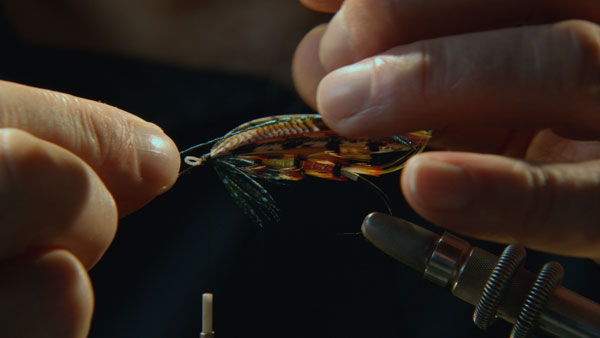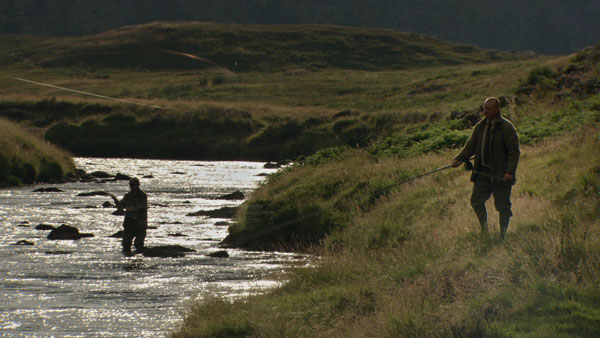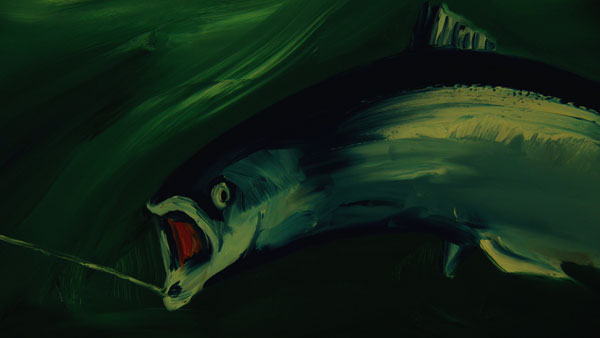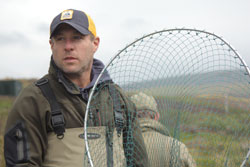For decades, on the edge of the Scottish coast, the enigmatic Megan Boyd learned and perfected the obscure craft of fly-making for fishermen. She twirled bits of feather, fur, silver, and gold into elaborate fishing flies, at once miniature works of art and absolutely lethal. Hailed as some of the best flies ever made, they have garnered her and her techniques an almost cult status. With breathtaking cinematography and expressive, hand-painted animation, acclaimed director Eric Steel captures the beauty and mysticism of Boyd and the fly-fishing art in this lyrical documentary, Kiss the Water.
Please describe Kiss the Water in your own words.
Eric Steel: Megan Boyd made devastating and mysterious fishing flies—tiny bits of feather and fur and fancy tinsel spun tightly round a tiny metal hook. Her whole life was wrapped up these creations—she lived alone in a small cottage in Northern Scotland, without electricity or running water.
Megan had been dead for ten years before I began making Kiss the Water—to me she was to me a mythical figure as much as a real one. I was told that she learned her craft by unraveling old flies and then rewinding them onto smaller and smaller hooks—a very tricky and precise exercise. And so I too set out to unravel her life, learn the patterns, to make a documentary that was also something of a mystery and something of a fairy tale wrapped around a very simple hook.
How did you learn about Megan?
ES: I am not a fisherman. I read the obituaries in The New York Times first thing every day—and in 2001 I came across Megan Boyd’s obituary and was oddly fascinated by it. At this point in my life, I was an executive in the film business—not yet a filmmaker—so when I clipped the piece from the paper, it was not because I knew there was a film to be made. I think I was more hypnotized by the words. All the patterns sounded like magic spells, and her life was like an invitation to a fairy tale.
The obituary stayed pinned to the wall near my desk for ten years—I could almost recite the words by heart. What I love most about this is that I still to this day am not certain why I had to make a movie about Megan Boyd—but I know I had this feeling like I was being called to.
What attracted you to fly fishing? It’s an interesting follow up to your previous film The Bridge.
ES: I have always loved objects that I can hold in my hands: books, cameras, pens, shells, eggs, etc. I suspect there was something just about the scale of Megan’s work—these miniature works of handicraft, art really, that you could twirl in your fingers—as long as you were careful about the barb!
Everything about The Bridge was about the grandness of scale, the enormity of the place, and the decisions people were making to end their lives. In Kiss the Water, everything is about the macro, the close-up, about life being wrapped up into something that was mysterious and seductive and also a bit illogical. Salmon don’t need to eat when they are in the river (they feed at sea), and so there is no good reason why they would snap up a feather fly! But there are also many similarities between The Bridge and Kiss the Water, including perhaps a sense of isolation and melancholy—and a very strong connection between soul and place.
Can you speak about your decision to use the hand-painted animated sequences to tell the story?
ES: Megan Boyd spent a lot of time alone, staring out her window, out to sea. There’s a difference between looking out a window and staring out one—looking is about seeing what is there, and staring is about longing, about what isn’t there. In order to tell a story about Megan’s life, I had to imagine what she dreamed about, what wasn’t there. The animation isn’t re-enactment, or the filling in of gaps—it’s a story unto itself, a thread if you will, like the kind Megan used to hold her flies together. What is so great about Em Cooper’s work is that she becomes the character in her animation—we filmed her, and then she painted the individual frames of the footage! It’s pretty special—a craft like Megan’s!!
What do you want audiences to take away from your film?
ES: I wouldn’t like to tell anyone what they should take away from Kiss the Water. Ask anyone who knows me: I despise the word ‘should.’ Norman Maclean, author of A River Runs Through It (one of my most favorite books and, to me, a mesmerizing film adaptation) spoke of fly fishing as a world apart, or a world within a world… and I hope people who come to watch Kiss the Water allow themselves, allow their minds to wander into this strange and stunningly beautiful world. I found a lot of meaning in the metaphors of fishing—and I’ve still not gone fishing.
Do you have one piece of advice for aspiring filmmakers?
ES: I worked in the movie business pretty much since the day I graduated from college. I thought that was pretty hot, actually. And I liked telling people that I made movies. But it wasn’t until I held the camera in my own hands and pressed the record button that I became a filmmaker. That’s pretty much all it takes to go from aspiring filmmaker to real filmmaker. More than anything, I believe filmmaking is a practice and a privilege of seeing and storytelling.
What are you most looking forward to at the 2013 Hamptons International Film Festival?
I think usually filmmaker respond by saying they can’t wait to see the other films and meet other filmmakers—but I’m actually looking forward to showing Kiss the Water to people I see almost every day in and around the Hamptons, and showing visiting filmmakers what an amazing place I get to live in. The fall is my favorite time in the Hamptons—and the light on the Atlantic is always cinematic!
Kiss the Water will screen at HIFF 2013 in the Views From Long Island section.
Follow Kiss the Water on Facebook and Twitter.
Eric Steel’s directorial and documentary debut, The Bridge, premiered at the Tribeca Film Festival in 2005 and was released theatrically across the United States and around the world. He was also the producer of Julie & Julia, executive producer of Angela’s Ashes, and co-producer of Bringing Out the Dead. He lives in Amagansett and New York City.










[…] 3:15pm 10/13, 11:45am Extras […]